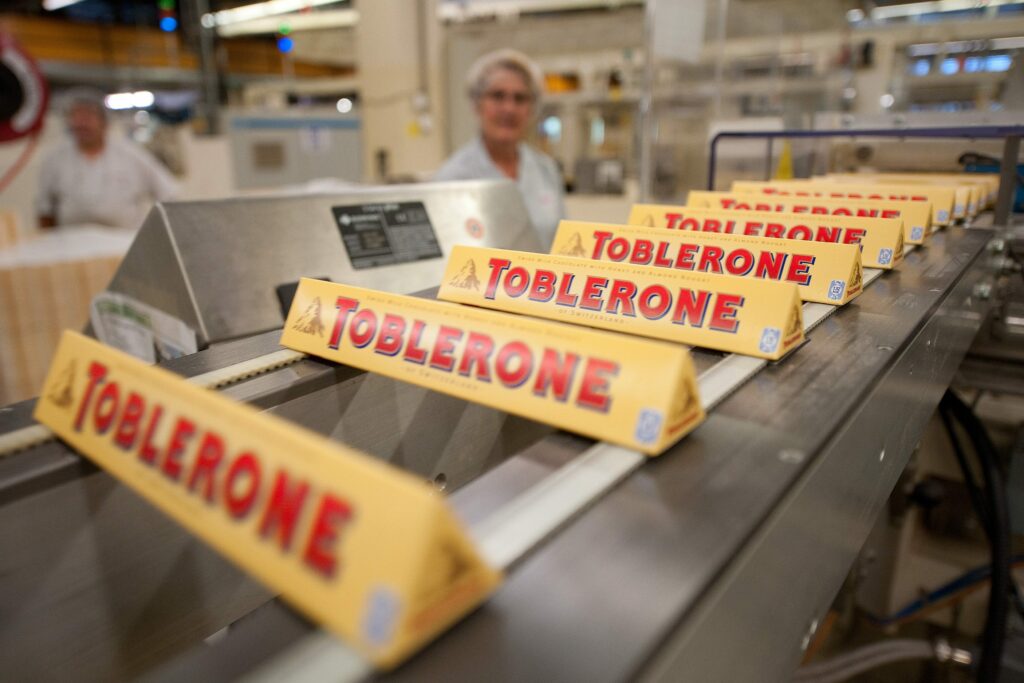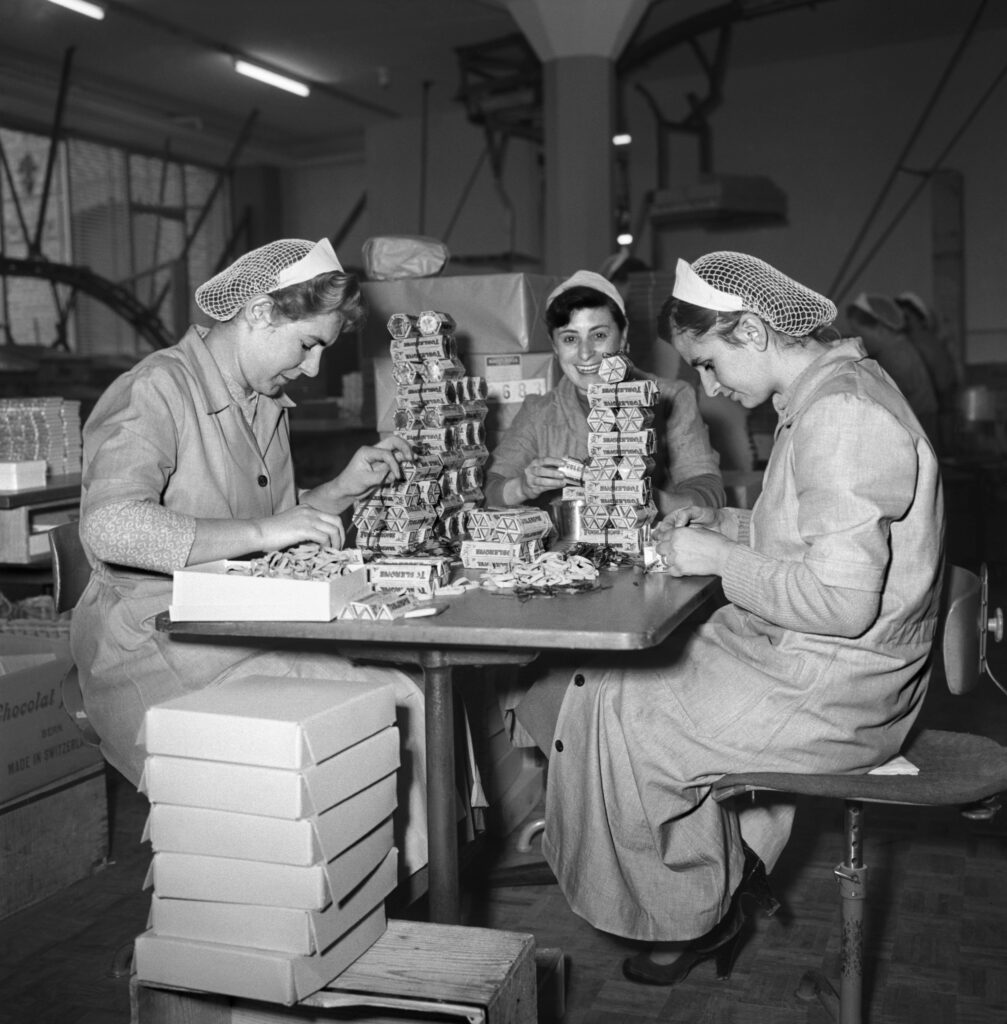Do., März 23rd 2023

Toblerone, its famed pyramid shape and iconic Matterhorn logo, is loved worldwide as a classic Swiss staple. But Toblerone’s U.S. owner Mondelez, which acquired the Swiss brand in 1990, announced last year that Toblerone would be moving part of its production to Slovakia in July, a change intended to cut costs and ramp up global production.
This move will have more consequences for the brand than a change of location — moving a majority of production out of Switzerland means Toblerone’s immortalized Matterhorn logo and the label “of Switzerland” has to go.
“For legal reasons, the changes we’re making to our manufacturing mean we need to adjust our packaging to comply with Swissness legislation. We have removed our Swissness claim from the front of the Toblerone pack and changed our description ‘of Switzerland’ to ‘established in,’” a Mondelez spokesperson told CNN.
It’s a significant change in the chocolate’s long history. Toblerone has been produced in Switzerland’s capital city Bern, for more than 115 years. The honey and almond nougat chocolate bar in the shape of a Swiss mountain peak, was invented in 1908 by Swiss chocolatiers Theodor Tobler and his cousin Emil Baumann.
The name Toblerone is a combination of Theodor’s last name, Tobler und Torrone, the Italian word for almond nougat. Within ten years of hitting store shelves, Toblerone was bringing in more than CHF100 million in annual revenue.

Now that Mondelez is moving most of the manufacturing from Bern to Bratislava, displaying the Matterhorn and “of Switzerland” on Toblerone’s packaging violates The Swissness Act of 2017.
The law states that to use Swiss iconography and qualify as Swiss-made, food products must source at least 80% of raw materials domestically (cocoa is an exception), and 100% of dairy products must be made in Switzerland.
Toblerone no longer meets Switzerland’s legal definition of “Swissness,” according to the Swiss media outlet Aargauer Zeitung.
The Swissness Act came into effect in 2017 when research revealed that associating a product with the country can add as much as 20% to the price. The legislation is intended to prevent the misuse of the “Made in Switzerland” label, the Swiss flag, historical sites, lakes, and other symbols that are inextricably Swiss.
“Swiss products and services are associated with exclusivity, tradition, and quality, with their good reputation inspires confidence in the product or service in question and ultimately influences the consumer’s buying decision,” explains Felix Addor, Deputy Director General of the Swiss Federal Institute of Intellectual Property.

Toblerone has proudly marketed its ‘Swissness’ for more than a century. In 2008, when Toblerone celebrated its 100th anniversary, it described itself as “a real piece of traditional Swiss chocolate.”
The chocolate’s original wrapper displayed an eagle and the label “The First Patented Swiss Milk Chocolate.” The eagle was soon replaced by the Bernese bear, a nod to the Swiss capital’s icon. In 1970, Toblerone added one of the most famous Swiss icons to its packaging — the Matterhorn where it has remained ever since.
Legend has it that the Matterhorn inspired the quirky triangle shape of Toblerone. However, according to Tobler’s sons, the inspiration was a show at the Folies Bergère – a music hall in Paris where dancers formed a massive human triangle.

The Swissness marketing strategy served the company well. In 2016, the company reported a record CHF400 million in annual revenue. But the move to Slovakia means Mondelēz has to take a new approach.
After Mondelēz announced in 2022 that it would be moving a portion of Toblerone production to Slovakia, the company partnered with the branding agency, Bulletproof, to update its brand story and visual identity. The fresh branding built on the slogan, Be more triangle, is an homage to the company’s founder and “Toblerone’s long tradition of being different in a world filled with rectangular and square chocolates.”
Nick Rees, Chief Creative Officer and Partner at Bulletproof, explained that: “Theodor Tobler broke the mold in his time – when others were creating squares, hemmed in by the refinement and rules of Swiss chocolate production, he went off on a tangent.”
The resulting collaboration produced updated packaging, introducing “vibrant and punchy notes of teal, orange, and magenta.” Toblerone also worked with the digital production company Media Monks to create a new e-commerce website.
The site gives consumers the option to customize their own chocolate bar with seven bold packaging designs and the possibility to add the recipient’s name and a personalized message. The distinctive designs use vibrant color palettes inspired by music, fashion, and art.

With Mondelēz relocating Toblerone’s production to Slovakia, Toblerone’s famous logo featuring the Matterhorn and hidden Bearnese bear are next on the chopping block. Changes to the new logo coming out this summer are being made to comply with “Swissness” labeling criteria from 2017.
A Mondelēz spokesperson reported to Sky News that a “distinctive” new Toblerone typeface would “draw further inspiration from the Toblerone archives and the inclusion of our founder, Tobler’s signature.”
The redesign will introduce a generic mountain logo consistent with the brand’s triangular aesthetic and the famous bear will be retained. The new packaging will also read “established in Switzerland” instead of “of Switzerland.” The new packaging will launch this summer.
Stefan Vogler, a marketing expert, told Watson that while removing the stamp of Swiss quality is never a good thing, the update will unlikely impact Mondelēz’s bottom line. Outside of Switzerland, “Toblerone should still be regarded as a Swiss brand by most consumers.”
Mondelēz has stated the Bern factory will remain in place, confirming that it had invested in its Bern factory to increase production of its 100-gram bars by CHF90 million a year.
“Bern is an important part of our history and will continue to be so for the future,” he said.
Dieser Artikel darf frei weitergegeben und nachgedruckt werden, vorausgesetzt, es wird auf den Originalartikel verwiesen.
